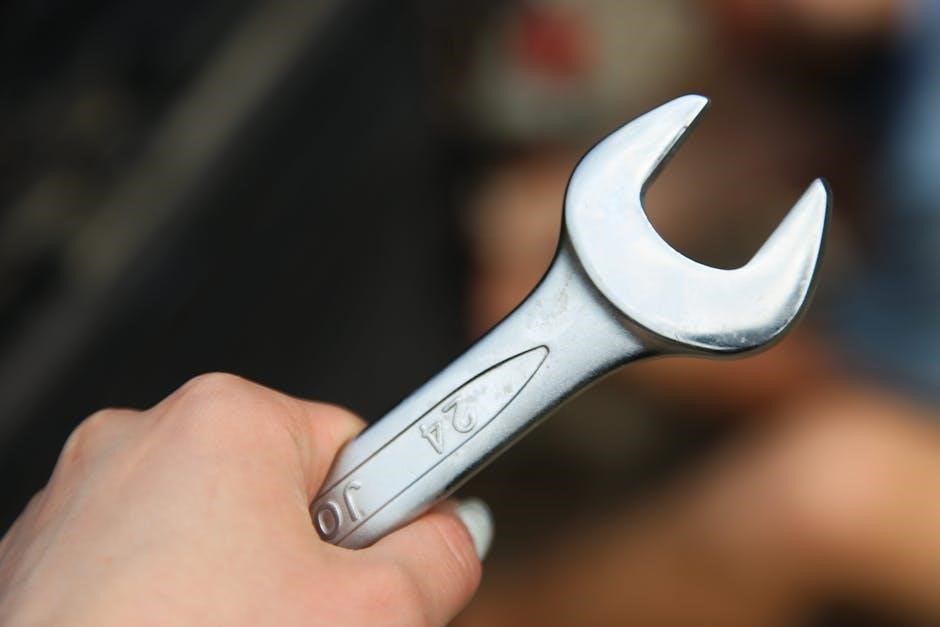Installation Instructions for Kaba Locks
Kaba locks offer keyless entry via PIN codes, eliminating key management hassles․ Designed for surface-mounted exit devices, they require no batteries and fit various door types․
1․1 Keyless vs․ Traditional Locks
Kaba keyless locks, like the Simplex series, offer PIN-based access, eliminating the need for physical keys․ This convenience enhances security and reduces management hassles․ Traditional locks rely on keys, which can be lost or duplicated, posing risks․ Keyless locks are ideal for high-traffic areas, providing easy access control without the burden of key tracking․ They also simplify code changes, ensuring quick updates for user permissions․ The mechanical design of Kaba locks means no batteries are required, making them reliable and low-maintenance․ This makes them a practical choice for businesses and facilities seeking efficient access solutions․
1․2 Surface-Mounted Exit Devices
Kaba surface-mounted exit devices are designed for seamless installation on doors, ensuring secure access control․ These locks, such as the Simplex series, are mechanically robust and ideal for high-traffic areas․ They eliminate the need for keys or cards, offering PIN-based entry for convenience․ Surface-mounted models are easy to install and maintain, with no batteries required․ They provide reliable operation and are suitable for controlling access between public and private spaces․ Their durability and low-maintenance design make them a popular choice for commercial and institutional settings, ensuring smooth functionality and enhanced security․

Operating Instructions
Operating Kaba locks is straightforward․ Enter your PIN code for access․ Codes are easily updated․ Models like Simplex 5000 and 1000 ensure secure, keyless performance․
2․1 Setting Up Access Codes
Setting up access codes for Kaba locks is a straightforward process․ For mechanical models like the Simplex series, simply enter the current code and press the knob to reset it․ Electronic models, such as the E-Plex series, may require administrator access․ Choose a code between 3-8 digits for optimal security․ Ensure the code is unique and communicated only to authorized users․ Codes can be updated without removing the lock from the door, providing flexibility․ For advanced systems, multiple codes can be programmed, including master and user codes, with options for temporary access․ Always test the code after setup to confirm functionality․
2․2 Managing User Permissions
Managing user permissions on Kaba locks involves assigning and revoking access efficiently․ For electronic models, administrators can create multiple access levels, from basic user codes to master codes with full control․ Temporary codes can be issued for visitors or contractors, ensuring limited access periods․ Audit trails in digital systems track user activity, enhancing security monitoring․ Permissions can be adjusted or removed via the lock’s keypad or through integrated software for smart systems․ Regular reviews of user permissions are recommended to maintain security integrity and prevent unauthorized access․ This feature-rich system ensures flexibility and control over who can enter specific areas at any time․ Always keep permissions updated to reflect current access needs․

Maintenance and Care
Regular maintenance ensures Kaba locks function optimally․ Clean keypads and mechanisms to prevent wear․ Lubricate hinges and check alignment for smooth operation․ Replace batteries promptly for electronic models to avoid lockouts․
3․1 Routine Maintenance Checks
Regular maintenance is crucial for Kaba locks to ensure reliability․ Inspect keypads for cleanliness and functionality․ Check door alignment to prevent mechanical stress․ Lubricate hinges and moving parts annually․ For electronic models, test battery levels and replace as needed․ Ensure all components are free from dust and debris․ Perform these checks every 6 months or as usage dictates․ Addressing issues early prevents costly repairs and ensures smooth operation․ Always refer to the manual for specific procedures tailored to your lock model․
3․2 Battery Replacement and Management
For Kaba locks requiring batteries, replace them every 2-3 years or when low-battery indicators appear․ Use high-quality alkaline batteries (e․g․, AA) to ensure reliability․ Open the battery compartment, typically located at the back or bottom of the lock․ Remove exhausted batteries and install new ones, ensuring correct polarity․ Dispose of old batteries safely․ If your lock has a battery-free design, no replacement is needed․ Always refer to the manual for specific instructions tailored to your lock model․ Proper battery management ensures uninterrupted operation and security of your Kaba lock․

Troubleshooting Common Issues
Common issues include access code errors and mechanical malfunctions․ Clean the keypad, check door alignment, and verify battery status․ Refer to the manual for detailed solutions․
4․1 Resolving Access Code Problems
Access code issues can often be resolved by resetting the code or ensuring proper keypad maintenance․ Forgotten codes can be reset using the master code․ If the lock doesn’t respond, check for dirt or moisture on the keypad․ Clean the surface with a dry cloth and retry․ Ensure dry hands when entering codes to avoid malfunctions․ If problems persist, refer to the manual for advanced troubleshooting steps or contact customer support for assistance․ Regular maintenance and code updates can prevent future issues․ Always keep the keypad clean and free from foreign substances․
4․2 Fixing Mechanical Malfunctions
For mechanical malfunctions, ensure proper door and latch alignment․ Misalignment can prevent smooth operation․ Clean the latch and strike plate regularly to remove dirt or debris․ Lubricate moving parts with silicone spray to maintain functionality․ If the lock fails to engage, check for obstructions or worn components․ Replace any damaged parts immediately․ Ensure the door closes securely to avoid mechanical stress․ Refer to the manual for specific repair instructions or contact a professional if issues persist․ Regular maintenance can prevent most mechanical problems and extend the lock’s lifespan․ Always follow safety guidelines when performing repairs․

Security Features
Kaba locks offer advanced security with PIN code access, eliminating key vulnerabilities․ High-security electronic locks comply with federal standards, ensuring robust protection․ Integration with smart systems enhances monitoring and control for superior safety․
5․1 Physical Security Measures
Kaba locks incorporate robust physical security measures, including tamper-resistant designs and durable materials․ The keyless entry system eliminates key vulnerabilities, reducing risks of duplication or loss․ Surface-mounted exit devices are designed to withstand forced entry, ensuring reliability․ High-security models, like the X-10 Type 1F, comply with federal standards for government applications․ These locks feature sturdy construction and resistance to mechanical tampering, providing a secure solution for various environments․ Their battery-free operation enhances reliability, as they don’t rely on external power sources․ This combination of features ensures Kaba locks deliver exceptional physical security for sensitive areas․
5․2 Digital Security Enhancements
Kaba locks feature advanced digital security enhancements, including microprocessor-controlled access systems․ The X-10 Type 1F model uses sophisticated computer security, making it harder for unauthorized users to bypass․ Electronic locks offer secure authentication methods, such as encrypted PIN codes, to prevent unauthorized access․ Some models include audit trail capabilities, allowing administrators to monitor access events․ These locks also incorporate anti-tamper technology to detect and prevent digital breaches․ With real-time monitoring and programmable access rights, Kaba locks ensure a high level of digital security, making them ideal for sensitive applications where data and physical security are critical․

Compatibility with Existing Systems
Kaba locks seamlessly integrate with smart home systems and various door types, ensuring compatibility without compromising functionality or security, enhancing overall system efficiency and user convenience․
6․1 Integration with Smart Home Systems
Kaba locks can be integrated with smart home systems, offering enhanced security and convenience․ Compatibility with technologies like Z-Wave and ZigBee allows seamless connectivity․ Users can control locks remotely via smartphones or voice commands through platforms like Alexa or Google Home․ This integration enables real-time monitoring, custom scenes, and automated locking/unlocking based on user preferences․ Smart home systems can also track access history, providing an additional layer of security․ Ensuring compatibility with various smart home platforms, Kaba locks offer a flexible and efficient solution for modern homes, enhancing both security and convenience in a connected environment․
6․2 Compatibility with Various Door Types
Kaba locks are designed to fit a wide range of door types, including wood, metal, and glass surfaces․ Their surface-mounted design ensures easy installation without requiring modifications to the door frame․ The locks are suitable for both single and double doors, making them versatile for different applications․ Additionally, Kaba locks can be adapted to various door thicknesses, ensuring compatibility with most standard and specialized door systems․ This flexibility makes them ideal for residential, commercial, and industrial settings, providing a secure and reliable solution across diverse environments․

Choosing the Right Kaba Lock
Choose the right Kaba lock by considering your application, security needs, and desired features․ Mechanical locks offer simplicity, while electronic locks provide advanced functionality and customization options for various applications․
7․1 Mechanical vs․ Electronic Locks
Kaba offers both mechanical and electronic locks, each with unique benefits․ Mechanical locks, like the Simplex series, provide keyless entry using PIN codes, eliminating the need for keys or batteries․ They are ideal for simplicity and durability, with easy combination changes․ Electronic locks, such as the E-Plex series, offer advanced features like programmable access codes, audit trails, and integration with smart systems․ They are suitable for higher security requirements and adaptability to modern access control needs, making them ideal for commercial and residential applications where advanced functionality is desired․
7․2 Specialized Locks for Different Applications
Kaba offers specialized locks tailored to specific needs, ensuring versatility across various settings․ Mechanical pushbutton locks, like the Simplex series, provide keyless convenience without batteries, ideal for public and private access control․ Electronic locks, such as the E-Plex series, feature programmable codes, audit trails, and smart home integration, suitable for high-security environments․ Government-grade locks, like the X-10 Type 1F, offer advanced security for sensitive areas․ Each model is designed to meet unique requirements, whether for residential, commercial, or specialized applications, ensuring robust security and ease of use․

Programming and Customization
Kaba locks allow easy programming of access codes and offer customization options․ Users can easily set and modify codes without removing the lock․ Advanced features enhance security․
8․1 Customizing Access Codes
Kaba locks simplify access code management, allowing users to easily set and modify codes․ The system eliminates the need for physical keys, enhancing convenience and security․ Codes can be changed in seconds without removing the lock from the door, making it ideal for frequent updates․ The Simplex 5000 series and other models offer this feature, ensuring flexibility for various applications․ Users can program multiple access codes, catering to different permission levels․ The process is straightforward, with clear instructions provided in the manual for seamless customization․ This feature ensures efficient access control and adapts to changing security needs․
8․2 Advanced Features and Settings
Kaba locks offer advanced features that enhance security and functionality․ Users can program multiple access codes, set temporary permissions, and integrate with smart home systems for seamless control․ The locks support audit trails, tracking entry history for improved monitoring․ Anti-pick pins and data encryption ensure high security․ Customizable settings include door-sensing technology to prevent unauthorized access․ The manual provides detailed guidance on configuring these features, ensuring optimal performance and adaptability to specific security needs․ These advanced settings make Kaba locks a versatile choice for modern access control requirements․
Safety and Emergency Access
Kaba locks ensure emergency access with override procedures, maintaining safe operation․ They provide reliable security while allowing swift intervention during emergencies, ensuring user safety and convenience always․
9․1 Emergency Override Procedures
Kaba locks are equipped with robust emergency override features to ensure immediate access during critical situations․ Mechanical override options allow authorized personnel to bypass electronic systems securely․ Priority codes can be programmed for rapid entry, while maintaining the integrity of the lock’s security․ Tamper-resistant designs prevent unauthorized access, even in emergency scenarios․ The locks also support integration with alarm systems, ensuring alerts are triggered during override attempts․ Detailed in the manual, these procedures balance security with accessibility, providing reliable solutions for emergencies without compromising safety standards․ Kaba locks ensure preparedness and control in crisis situations․
9․2 Ensuring Safe Lock Operation
Kaba locks prioritize user safety through intuitive design and fail-safe mechanisms․ The locks ensure doors open easily in emergencies, with clear exit routes maintained․ Regular maintenance is crucial to prevent mechanical issues, while anti-pick pins and tamper-resistant features enhance security․ Battery-powered locks have low-power alerts to avoid lockouts, and keyless options eliminate the risk of lost keys․ Compliance with safety standards ensures reliability, while user-friendly interfaces reduce operational errors․ By adhering to the manual’s guidelines, users can uphold both security and safety, ensuring Kaba locks function optimally in all conditions․ Proper installation and periodic checks further safeguard performance and user well-being․

Legal and Regulatory Compliance
Kaba locks meet GSA standards and Federal Specifications, ensuring compliance with legal requirements for security and durability, making them suitable for high-security applications and government use․
10․1 Meeting Building Codes
Kaba locks are designed to meet stringent building codes and regulatory requirements, ensuring compliance with safety and security standards․ They adhere to Federal Specifications like FF-L-2890C and are GSA-approved for high-security applications․ The locks are rigorously tested to ensure durability and reliability, making them suitable for government and commercial use․ Their design flexibility allows them to fit various door types while maintaining code compliance․ Refer to the Cencon 4 Reference Manual for detailed specifications and installation guidelines․ Always consult local building codes and regulatory bodies to ensure proper compliance․ Kaba locks are a reliable choice for meeting legal and safety standards․
10․2 Adhering to Security Standards
Kaba locks are engineered to meet rigorous security standards, ensuring advanced protection for sensitive areas․ They comply with Federal Specifications like FF-L-2890C and are GSA-approved, making them ideal for high-security applications․ The locks feature sophisticated computer security, with microprocessors that simplify dialing compared to traditional combination locks․ Models like the Samp;G 2740 combination lock enhance security further․ Kaba electronic locks use keycards instead of keys, offering modern security enhancements․ These locks are designed to withstand tampering and unauthorized access, ensuring they meet or exceed industry security benchmarks for reliability and safety․

Downloading and Accessing Manuals
Kaba locks manuals are available for download from official sources like usermanual․wiki and all-guides․com, offering detailed guides for models such as Simplex 5000, 1000, 3000, and 3100․
11․1 Official Sources for Manuals
Kaba lock manuals are accessible via official platforms like usermanual․wiki and all-guides․com․ These websites offer comprehensive guides for various models, including the Simplex 5000, 1000, 3000, and 3100 series․ Users can download PDF versions of these manuals for free, ensuring they have detailed instructions for installation, operation, and maintenance․ Additionally, Kaba’s official website provides specific resources, such as the Cencon 4 Reference Manual, which is essential for advanced configurations․ These official sources are reliable and up-to-date, ensuring accurate information for optimal lock functionality and troubleshooting․
11․2 Navigating the Manual Content
Kaba lock manuals are structured to provide clear, step-by-step guidance․ Users can easily navigate by referring to the table of contents, which outlines sections like installation, operation, and troubleshooting․ Each manual is organized by model, such as the Simplex 5000 or 1000 series, ensuring specific instructions are accessible․ Key features like PIN code setup, battery replacement, and maintenance are highlighted for quick reference․ Detailed diagrams and troubleshooting guides further enhance usability; By following the manual’s logical flow, users can efficiently locate and apply the information needed for their Kaba lock model, ensuring optimal functionality and security․
Best Practices for Use
Regularly clean the keypad and ensure dry hands when operating the lock․ Schedule routine maintenance checks to ensure optimal functionality and security of your Kaba lock system․
12․1 Maximizing Lock Functionality
To maximize the functionality of your Kaba lock, ensure proper installation and regular maintenance․ Clean the keypad frequently to prevent dirt and moisture interference․ Always use dry hands when entering PIN codes to avoid malfunctions․ For electronic models, check battery levels regularly and replace them as needed․ Ensure the door alignment is precise to maintain the lock’s performance․ Update access codes periodically to enhance security and restrict unauthorized entry․ Refer to the manual for specific guidelines on customizing settings and troubleshooting common issues․ By following these practices, you can ensure your Kaba lock operates efficiently and securely over time․
12․2 Enhancing Security Practices
To enhance security, use strong, unique access codes and limit permissions to essential users․ Regularly update codes and audit access logs to monitor usage․ Enable advanced features like anti-pick pins and tamper alerts for added protection․ Ensure physical security by installing locks on solid-core doors and reinforcing frames․ Train users to avoid sharing codes and report suspicious activity․ Consider integrating smart home systems for real-time monitoring․ By combining these practices, you can significantly improve the security and effectiveness of your Kaba lock system, ensuring safe and controlled access at all times․
